Abstract
Several application possibilities exist in terms of polymer-bonded magnets, such as the sensors or smaller motors, for example, in the window operators of cars. Increasing demand and rising environmental awareness necessitate a higher understanding in terms of the possible recycling strategies for polymer-bonded magnets, especially in the context of a circular economy; post-consumer materials are barely available in terms of polymer-bonded magnets. This paper investigates the focused aging of polymer-bonded magnets based on thermoplastics and ferrite-based fillers via temperature and chemical treatment to reveal the post-industrial products representative of post-consumer products via fast aging. The changes in the dimension and the magnetic properties via these treatments are analyzed. Further, new samples are produced with 50 weight-% of recycled material to investigate the impact of the treatment on the magnetic properties of recycled samples. It was proven that both the dimension and magnetic properties were affected by the treatments. Unexpectedly, the magnetic properties increased with the fast aging based on the temperature treatment due to a so-called “snowball effect”. In addition, only the magnetic properties changed within the recycled material, where they reached about 100 mT and were about the same to 20% less relative to the ideal remanence BR value. With these investigations, the usability of the recycling strategy of reusing shreds in terms of thermoplastic-based polymer-bonded magnets with ferrite-based fillers was proven in terms of the post-industrial products representative of post-consumer products via fast aging.
1. Introduction
1.1. Fundamentals of Polymer-Bonded Magnets Regarding Material, Processing, and Application
The development of materials for permanent magnets began in the 20th century, leading to the discovery of several material groups within just a few years. Notable examples include the aluminum–nickel alloy (AlNi) identified in 1933 and hard ferrites found in 1950 [1]. In 1970, new manufacturing techniques broadened the application possibilities for polymer-bonded magnets [2]. This innovative method was based on material composition, as polymer-bonded magnets consist of a matrix material (the polymer) and a hard magnetic filler [3], and allowed the injection molding of bonded magnets, which enhanced design flexibility and opened avenues for functional integration [2]. However, the manufacturing process is significantly influenced by the type of matrix material used. Thermoplastic-based polymer-bonded magnets are typically produced through injection molding, with a maximum filler content of 65 vol.-% [4]. In contrast, thermoset-based polymer-bonded magnets are usually processed by pressing, which allows for a filler content of up to 85 vol.-% [5]. Early efforts to produce thermoset-based polymer-bonded magnets via injection molding aimed to merge the advantages of this processing method with the material benefits, including low viscosity, improved filler orientation, and resistance to high temperatures and chemicals [4,6].
In the context of polymer-bonded magnets, two primary groups of hard magnetic fillers can be identified: hard ferrites and rare earth materials. These fillers play a crucial role in determining the magnetic properties of the samples, varying in geometry, particle size, and intrinsic magnetic characteristics [7]. Hard ferrites, such as strontium ferrite oxide (SrFeO), typically have a particle size ranging from 1 to 10 µm and exhibit a hexagonal morphology. In contrast, neodymium iron boron (NdFeB) features a larger particle size, between 100 and 400 µm, with a plate-like structure [8]. In terms of magnetic properties, NdFeB has a remanence (BR) that is approximately three times greater than that of SrFeO, as well as a resistance to demagnetization that is two to three times superior [9]. Hard magnetic fillers can be used in isotropic or anisotropic configurations. For anisotropic fillers, the remanence BR can achieve up to 85% of the saturation flux density (BS), while isotropic fillers only reach about 50% [10]. To utilize the material potential of anisotropic fillers, they must be oriented along a preferred direction during the manufacturing process, which requires a certain level of mobility among the fillers [11]. In addition to physical orientation, the magnetic moments within the dipoles—the smallest magnetic units—must also be magnetized. This magnetization can take place post-fabrication, often utilizing an impulse magnetizer [12].
The applications of polymer-bonded magnets can be divided into two primary categories: sensor applications and actuator implementations. In the automotive industry, thermoplastic-based polymer-bonded magnets are produced in the millions each year [3]. In 2007, approximately 95% of polymer-bonded magnets utilized hard ferrites, largely due to their cost-effectiveness [13]. In terms of market value, neodymium iron boron (NdFeB) commands a share of 62%, while hard ferrites represent 34% [14]. Recent research has concentrated on integrating polymer-bonded magnets into motor applications, specifically in rotors for electric mobility, through their incorporation into electromagnetic stacks. New concepts leverage the principles of reluctance and variations in magnetic resistance [4,15]. By the year 2030, the electric mobility sector is projected to face a shortfall of about 48,000 tons of NdFeB, which would correspond to around 25 million electric vehicles [16].
1.2. Strategies and Usage for the Recycling of Polymer-Bonded Magnets
To meet the increasing demand for hard magnetic fillers in magnets, three main approaches can be pursued. First, the input of materials can be minimized through efficiency improvements, such as implementing the injection-molding process in the production of permanent magnets and taking advantage of geometric flexibility [16,17]. Second, limited elements can be replaced with alternative chemical elements, different materials, or innovative technologies [3]. Within the latter approach, polymer-bonded magnets can be recycled, primarily aiming to recover the hard magnetic fillers. In terms of thermoplastic-based polymer-bonded magnets, this means mainly a mechanical reusage of the shreds [18], a chemical based on solvolysis or a thermal strategy via energy or filler recovery. If thermoset-based polymer-bonded magnets are to be recycled, the thermal strategy via energy recovery is mainly applied. Within the chemical-based methods, special routes are realized to some extent by solvolysis, the bond exchange reaction, or the integration of specific monomers [12]. However, these methods can only be applied in the case of specific monomers, and this is not a commonly usable solution. First attempts have been made to recover the fillers from thermoset-based polymer-bonded magnets using pyrolysis. It has been shown that pure pyrolysis in an oxygen atmosphere causes oxidation of the hard magnetic fillers, resulting in a reduction in magnetic properties of up to 90%. This decline can be mitigated by modifying the pyrolysis conditions, such as using a cover to limit oxygen flow or applying a nitrogen atmosphere. These adjustments can reduce the loss of magnetic properties to between 20% and 30%. However, implementing these methods can be quite costly, making them less feasible in the context of a realistic circular economy [18]. Another attempt was made implementing the mechanical reusage of shreds in terms of thermosets. It was proven that the magnetic properties are reduced by at least 15%, with a reduction in the required energy and CO2 emission of 90% compared to pyrolysis [19].
Although a number of different recycling strategies have been investigated in the area of polymer-bonded permanent magnets, hardly any are currently being used. In collaboration with project partners, as part of the project “Recycling von Magnetwerkstoffen für die Verwendung in kunststoffgebundenen Dauermagneten” (reference number: 38099/01-31), some inhibition thresholds were identified that prevent the establishment of a circular economy in the context of polymer-bonded permanent magnets. The main reasons can be seen, among other things, in the complex material composition and the high political framework conditions. In addition, recycling is currently economically viable to a limited extent. A significant lack of take-back systems and a limited recycling infrastructure, as well as little consumer commitment, currently do not allow a circular economy for polymer-bonded permanent magnets. As a result, the possible recycling strategies are currently being evaluated on new samples or post-industrial material after production, without taking the influence of the application conditions such as temperature or chemicals into account. Post-consumer products are hardly available due to the inhibition thresholds explained. After one inhibitor was found to be the lack of knowledge about the possibility of recycling polymer-bonded magnets based on post-consumer materials, there is a strong need for research in this area. To reduce the gap in the understanding of the behavior of post-consumer materials in terms of polymer-bonded magnets within the recycling process will greatly increase the possibility of leading polymer-bonded magnets into a circular economy. Taking the massive gap of the required materials into account (as explained in Section 1.1), this bridging is intensively necessary.
To increase the possibility of implementing a circular economy in terms of polymer-bonded permanent magnets, the aim of this paper was the investigation of the influence of application conditions on the magnetic properties of the samples. Further, the possible magnetic properties, which can be reached by this post-industrial material, which was treated thermally or chemically similar to the possible applications, were evaluated. The investigation was based on a thermoplastic matrix material and a ferrite-based filler system.
2. Results
2.1. Differential Scanning Calorimetry (DSC) Following DIN EN ISO 11357 [20]
To evaluate the impact of the temperature and chemical treatments, as well as the material behavior before and after the usage of the recycled material, Figure 1 shows the route of the DSC measurements in terms of the second heating and cooling cycle. Within the second heating stage, the material beside the new one shows a double peak with a reduced required enthalpy. Further, the melting peak temperature is shifted slightly toward higher temperatures within the material variations after the treatment. The melting peak temperature is similar for the new and recycled material, which allows the usage of the same fabrication conditions, as shown in Section 3.2. It seems that the temperature and chemical treatments changed the polymer structure. The temperature treatment might cause a temper effect, with which the double peak and especially the higher melting peak temperature is likely to be reached. This goes along with a change in the crystallites, where larger ones are built within the higher temperature and given time. Within the cooling stage, the crystallization peak temperature shifted to lower temperatures in terms of the recycled material and the one that was treated with temperature in comparison to the new material. With that, the temperature treatment affects the polymer structure and can be based on both physical and chemical aging processes. The impact of the chemical treatment is not clear, yet it only affects the melting peak temperature.
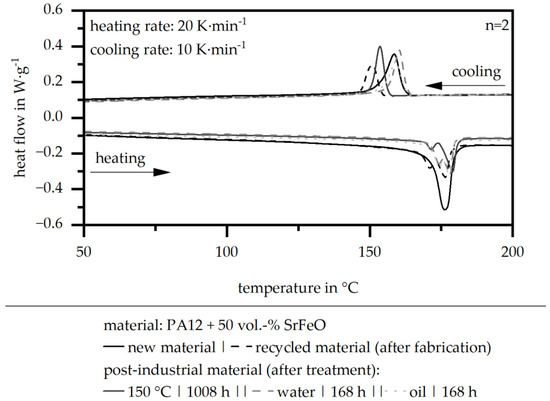
Figure 1.
Route of the DSC measurement relative to the treatment conditions and the amount of recycled material [matrix: PA12 | filler: SrFeO | filler grade: 50 vol.-%].
2.2. Geometry Changes
Figure 2 depicts the change in the thickness relative to the different temperature levels and time intervals (left) and relative to the chemical treatment (right). The thickness increases with higher time intervals, except for the temperature level of 120 °C, mainly because the outer diameter increases as well. The standard deviation is high, which goes along with the changing measurement positions and divergences within the conditioning process. However, the trend of increasing thickness can be clearly seen. Further, it can be seen that the dimension change goes along with the level of the temperature. In terms of the chemical treatment, the dimension increases as well, mainly due to diffusion and swelling processes. With respect to the DSC measurement (as shown in Figure 1), the melting peak has its onset temperature slightly above 150 °C, which means that the chosen temperature level leads to rapid aging, and with that, a dimensional change is likely to occur as the polymer structure is already moveable to some extent. The change in the width reveals a recognizable trend. Yet, it is not clear why the dimensional change only happens in terms of the diameter, rather than in terms of the width.
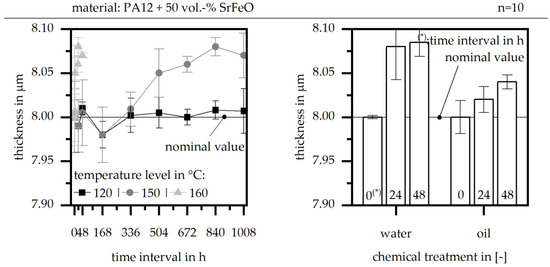
Figure 2.
Impact of the time interval in terms of the temperature treatment (left) and chemical treatment (right) on the thickness of the samples [matrix: PA12 | filler: SrFeO | filler grade: 50 vol.-%].
Further, the dimensional change within the samples made of recycled material is insignificant, which leads to the fact that only the treatment itself affects the dimensional change. Therefore, the production of new samples out of post-industrial material allows a high dimensional accuracy, as long as the recycled material includes around 50 weight-% of new, untreated material.
2.3. Magnetic Properties
Similar to the change in the thickness, Figure 3 shows the impact of the different temperature levels and time intervals (left) as well as the chemical treatment (right) on the remanence BR. In terms of the temperature treatment, the remanence BR increases with longer time intervals, which was not expected. The temperature levels were chosen in terms of a rapid aging, and the time intervals should be stopped within reaching half of the initial value of BR. However, it can be clearly seen that BR increases with longer time intervals, especially in terms of the temperature level of 150 and 160 °C, even though the standard deviation is high. It can be assumed that the higher temperature allows molecular movement to some extent, with which the oriented fillers affect unoriented ones within a certain perimeter. Therefore, the amount of oriented fillers can be increased, which leads to higher magnetic properties. In terms of the chemical treatment, the remanence BR is reduced during the interaction with the media and with increasing time. This goes along with a reaction between the filler and the chemicals that could lead to oxidation or a change in the polymer structure due to the chemical treatment.
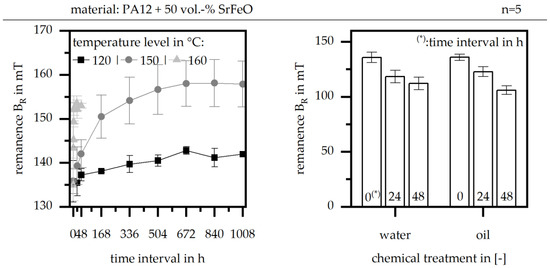
Figure 3.
Impact of the time interval in terms of the temperature treatment (left) and chemical treatment (right) on the remanence BR [matrix: PA12 | filler: SrFeO | filler grade: 50 vol.-%].
In general, the temperature and chemical treatments revealed a change in the magnetic properties of post-industrial products with rapid aging effects.
Figure 4 compares the magnetic properties by the value of the remanence BR in terms of the post-industrial material (after the treatment) and the recycled material (after the fabrication). Further, the highest and lowest boundary of the possible remanence BR in terms of the recycled material is shown. The filler SrFeO of the type OP-71 has an initial BR of 439 mT. If the fillers in the post-industrial material (with 50 vol.-% filler grade) are fully oriented, theoretically, the remanence BR can reach a value of 219.5 mT. Within the recycled material, the total filler grade is again 50 vol.-%, which means that the ideal BR is 219.5 mT. However, if the reduction in magnetic properties through the treatment is taken into account, the ideal value reaches only 294.5 mT. If all fillers within the recycled material are oriented, the highest possible magnetic property is 147.25 mT. If only the new material within the recycled samples would contribute to the magnetic properties, the middle boundary is reached with a value of 73.63 mT. If none of the filler material is oriented, the lowest boundary is arrived at with the value of 36.8 mT. Taking into account that already within the fabrication of the post-industrial material only 70% of the ideal value of BR is reached, the magnetic properties within the recycled material must be partly realized by the post-industrial material and not only by the new material. Nevertheless, the remanence BR is reduced in terms of the pre-treatment within the post-industrial material. Relative to the conditions of the treatment, the dimension of the reduction varies between 50 and 70% in terms of the ideal value. However, authors have interpreted this reduction to be within an adequate range to reuse post-industrial materials within the magnetic context. The magnetic properties of virgin material (without any treatment) reach 100 mT, and it is therefore comparable to recycled materials within these investigations.
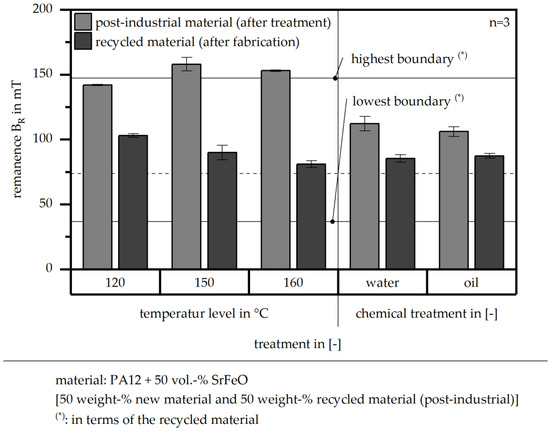
Figure 4.
Impact of the time interval in terms of the temperature treatment (left) and chemical treatment (right) on the remanence BR relative to the change in the material in terms of the post-industrial (after treatment) and recycled material (after fabrication) [matrix: PA12 | filler: SrFeO | filler grade: 50 vol.-%].
3. Materials and Methods
3.1. Material
The experiments were based on the matrix material polyamide 12 (PA12) of the type Vestamid BS 1636 (Evonik Industries AG, Essen, Germany) and the hard magnetic filler SrFeO of the type OP-71 (Dowa Holdings Co., Tokyo, Japan). The filler grade was kept constant at 50 vol.-%.
3.2. Fabrication of the Samples
The test samples were produced pressure controlled using a Demag Ergotech 25/280-80 injection-molding machine (Sumitomo (SHI) Demag Plastics Machinery GmbH, Schwaig bei Nuremberg, Germany) with a screw diameter of 18 mm. The circular and multipolar samples had an outer diameter of 30.6 mm and an inner diameter of 22.6 mm with a width of 5 mm, as shown in Figure 5.
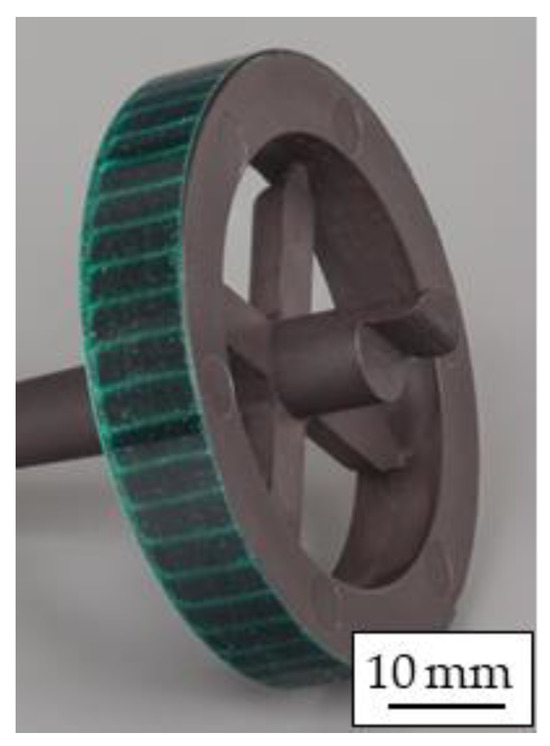
Figure 5.
Circular and multipolar sample with a flux foil on the outer diameter to illustrate the magnetic field.
The process conditions were kept constant with a melt temperature of 280 °C, a mold temperature of 80 °C, an injection velocity of 80 mm∙s−1, and a holding pressure of 500 bar.
Since post-consumer samples were not available, the samples underwent accelerated aging via temperature and chemical treatments. With respect to the application fields and the conditions within the usage, temperature, water, and oil were investigated as influencing factors. The oil was chosen in terms of a base oil, which was a polar ester with 2 weight-% antioxidants. The samples were placed in a convection oven (type: UT 6050 K; Heraeus Instrumens, Hanau, Germany) at different temperatures and time intervals. The samples that were only treated by temperature were hung within the convection oven to ensure a homogenous air flow across their whole surface. In terms of assessing the influence of the chemicals, the samples were placed in preserving jars. Again, the samples were positioned in such a way that their whole surface was covered with the chemicals. Table 1 summarizes the different storage conditions and time intervals for the samples.

Table 1.
Overview of the different storage conditions and time intervals in terms of accelerated aging.
Five representative samples were selected to analyze the change in the magnetic properties with respect to the different time intervals and storage conditions. The long-term application temperature of the material was set to 90 °C. After the temperature level of 160 °C is much higher compared to that level, the change in material behavior in terms of the magnetic properties was analyzed over short time intervals.
After the samples underwent the aging treatment, they were demagnetized by a permagraph of the type C-300 (company: Magnet-Physik Dr. Steingroever GmbH; Cologne, Germany), and the material was milled by a press (type: RWP 700; ATM Group, Blieskastel, Deutschland). The demagnetization within a permagraph is based on a decreasing hysteresis loop with a changing polarization direction. This treatment is combined with high material stress within the permagraph and was therefore performed for a small amount of samples. The so-called recycled material based on treated post-industrial products was mixed with 50 weight-% of the new material. Afterwards, samples were fabricated, again using the injection-molding machine mentioned above, with the same process conditions.
3.3. Characterization
3.3.1. Differential Scanning Calorimetry (DSC) Following DIN EN ISO 11357 [20]
To characterize the heating and cooling behavior of the material, DSC measurements were performed on the basis of DIN EN ISO 11357 [20] (TA-Instruments, New Castle, DE, USA). The material was heated to 220 °C at a rate of 20 °C per minute in the first heating cycle. Afterwards, the material was cooled to 0 °C at a rate of 10 °C per minute with an isothermal step of 0.5 min before and 5 min after. The material was reheated again to 220 °C in the second heating cycle. The melting peak temperature during the second heating and the crystallization peak temperature during cooling were determined.
3.3.2. Geometry Changes
The influence of the temperature and chemical treatments was evaluated using an outside micrometer (Hoffmann Group, Munich, Germany) to determine the thickness (difference between inner and outer diameter) and width at 10 different positions for each sample.
3.3.3. Magnetic Properties
The determination of the magnetic properties (remanence BR) was realized by a specific test rig where the samples are picked up via a clamping device. The flux density was recorded radially via a Hall sensor relative to the rotation angle of the sample, while the rotation speed was kept constant. The angle of rotation was received using a rotary encoder (Heidenhain GmbH, Traunreut, Germany). To ensure a comparison between the samples, as well as within one sample, and the different time intervals, a defined position was specified on the sample, which was taken into account during the measurements.
4. Conclusions
Within this paper, the influence of different temperature and chemical treatments on the dimension and magnetic properties of polymer-bonded magnets was investigated. The analysis was based on a thermoplastic matrix and a ferrite-type of filler. This paper showed that the dimension and the remanence BR changed relative to the temperature level and time interval of the treatment, as well as the chemical treatment. In terms of the temperature treatment, a fast aging was expected; however, after reaching a certain temperature level, the magnetic properties increased due to a “snowball effect” in terms of the orientation of the ferrite-based fillers. This means that due to a certain movability of the fillers within the higher temperature setting, the magnetic field of an oriented filler interacts with close-lying fillers and orients them as well. With that, the treatment on post-industrial products—representative of post-consumer materials—revealed that the dimension and magnetic properties changed, especially in terms of the temperature, where BR increases. Further, the magnetic properties of samples out of the post-industrial material (with 50 weight-% new material) were analyzed. It was proven that partly the recycled material is oriented within the new fabrication process and contributes therefore to the magnetic properties. The reachable magnetic properties with post-industrial products—representative of post-consumer materials—are rated as appropriate and suitable for applications where the magnetic force is only needed up to a value of 100 mT. In addition, the mixture of the material, especially in terms of recycled material, has a huge impact on the dimensional accuracy of samples. Therefore, it has to be taken into account that the mixture of the material affects both the swelling and thermal aging behavior. With that, the possible applications, even in terms of recycled materials, can be expanded.
Author Contributions
U.R.: conceptualization, methodology, validation, investigation, writing—original draft, visualization; D.D.: writing—review and editing, project supervision. All authors have read and agreed to the published version of the manuscript.
Funding
This research was funded by the “Deutsche Bundesstiftung Umwelt” within the project “Recycling von Magnetwerkstoffen für die Verwendung in kunststoffgebundenen Dauermagneten” (reference number: 38099/01-31).
Data Availability Statement
Restrictions apply for the availability of these data. Data are available with the permission of the author.
Conflicts of Interest
The authors declare no conflicts of interest. The funders had no role in the design of the study; in the collection, analyses, or interpretation of data; in the writing of the manuscript; or in the decision to publish the results.
References
- Cassing, W.; Kuntze, K.; Ross, G. Dauermagnete: Mess-und Magnetisierungstechnik, 3rd ed.; Expert: Renningen, Germany, 2018. [Google Scholar]
- Ormerod, J.; Constantinides, S. Bonded permanent magnets: Current status and future opportunities (invited). J. Appl. Phys. 1997, 81, 4816–4820. [Google Scholar] [CrossRef]
- Michalowsky, L.; Schneider, J. Magnettechnik: Grundlagen, Werkstoffe, Anwendungen, 3rd ed.; Vulkan: Essen, Germany, 2006. [Google Scholar]
- Rösel, U. Zum Spritzgießen Multipolarer Kunststoffgebundener Dauermagnete auf Duroplast-Basis; Dissertation: Erlangen, Germany, 2023. [Google Scholar]
- Ohmori, K.; Hayashi, S.; Yoshizawa, S. Injection-molded Sm-Fe-N anisotropic magnets using unsaturated polyester resin. J. Alloys Conpounds 2006, 408–412, 1359–1362. [Google Scholar] [CrossRef]
- Maenz, T. Spritzgießtechnische Herstellung Duroplastgebundener Dauermagnete; Dissertation: Chemnitz, Germany, 2018. [Google Scholar]
- Hering, E.; Martin, R.; Stohrer, M. Physik für Ingenieure, 12th ed.; Springer: Berlin/Heidelberg, Germany, 2016. [Google Scholar]
- Ivers-Tiffée, E.; Münch, W. Werkstoffe der Elektrotechnik, 10th ed.; B. G. Teubner: Wiesbaden, Germany, 2007. [Google Scholar]
- Ormerod, J. Bonded Magnets: A Versatile Class of Permanent Magnets. Magn. Bus. Technol. 2015, 8–11. [Google Scholar]
- MS Schramberg GmbH & Co. KG. Umfassend. 2010. Available online: https://www.magnete.de/de.html (accessed on 26 October 2021).
- Jung, I.; Kang, T.G.; Shin, D.S.; Park, S.J. Modeling of Magnetic particle Orientation in Magnetic powder injection molding. J. Phys. D Appl. Phys. 2018, 51, 115002. [Google Scholar] [CrossRef]
- Johannaber, F.; Michaeli, W. Handbuch Spritzgießen, 2nd ed.; Carl Hanser: München, Germany, 2004. [Google Scholar]
- Sugimoto, S. Current status and recent topics of rare-earth permanent magnets. J. Phys. D Appl. Phys. 2011, 44, 064001. [Google Scholar] [CrossRef]
- Buchert, M.; Manhart, A.; Suttler, J. Untersuchung zu Seltenen Erden: Permanentmagnete im industriellen Einsatz in Baden-Württemberg. In Studie im Auftrag des Ministeriums für Umwelt, Klima und Energiewirtschaft Baden-Württemberg; Öko-Institut e.V.: Freiburg im Breisgau, Germany, 2014. [Google Scholar]
- Dolgirev, J.; Kalter, M.; Urschel, S.; Funck, R.; Jung, J.; Schimmelpfennig, V. Resource-saving Cirulating Pump on basis of an Integrated Synchronous-Reluctance Drive System. In Proceedings of the 2019 IEEE 4th International Future Energy Electronics Conference (IFEEC), Singapore, 25–28 November 2019; pp. 1–7. [Google Scholar]
- Arnold, H. Seltene Erden Werden Selten: Magnete für E-Autos Könnten Knapp Werden, 2020. Available online: https://www.elektroniknet.de/automotive/wirtschaft/magnete-fuer-e-autos-koennten-knapp-werden.179916.html (accessed on 22 January 2021).
- Gutfleisch, O.; Willard, M.A.; Brück, E.; Chen, C.H.; Sankar, S.G.; Liu, J.P. Magnetic materials and devices for the 21st century: Stronger, lighter, and more energy efficient. Adv. Mater. 2011, 23, 821–842. [Google Scholar] [CrossRef] [PubMed]
- Rösel, U.; Drummer, D. Possibilities in Recycling Magnetic Materials in Applications of Polymer-Bonded Magnets. Magnetism 2022, 2, 251–270. [Google Scholar] [CrossRef]
- Rösel, U.; Drummer, D. Evaluation of a recycling strategy for polymer bonded magnets based on thermosets. Recycling 2024, 9, 81. [Google Scholar] [CrossRef]
- Deutsches Institut für Normung e., V. Kunststoffe—Dynamische Differenz Thermoanalyse (DSC): Teil 1: Allgemeine Grundlagen; Beuth Verlag GmbH: Berlin, Germany, 2016. [Google Scholar]
Disclaimer/Publisher’s Note: The statements, opinions and data contained in all publications are solely those of the individual author(s) and contributor(s) and not of MDPI and/or the editor(s). MDPI and/or the editor(s) disclaim responsibility for any injury to people or property resulting from any ideas, methods, instructions or products referred to in the content. |
© 2025 by the authors. Licensee MDPI, Basel, Switzerland. This article is an open access article distributed under the terms and conditions of the Creative Commons Attribution (CC BY) license (https://creativecommons.org/licenses/by/4.0/).